Cross-Cultural Management and Globalization: Norberg's Assertion
VerifiedAdded on 2022/10/10
|8
|1978
|41
Essay
AI Summary
This essay delves into the multifaceted topic of globalization from the perspective of a cross-cultural manager, critically analyzing the arguments presented by Johan Norberg and Naomi Klein. It begins by defining globalization and providing examples of its impact, such as McDonald's. The essay explores Norberg's assertion that globalization is beneficial, highlighting its role in economic growth and contrasting it with Klein's view that corporations exploit globalization for profit through branding. The paper evaluates both viewpoints, utilizing theories like Hofstede's cultural dimensions and the Iceberg model to understand cross-cultural behaviors and conflicts. The analysis includes examples like the economic transformations in Taiwan and Kenya, and the role of multinational corporations in Vietnam. The essay concludes by agreeing with Norberg's assertion, emphasizing the benefits of globalization, such as improved economic growth, better wages, and a skilled workforce. It also stresses the importance of understanding cultural theories for effective cross-cultural management.
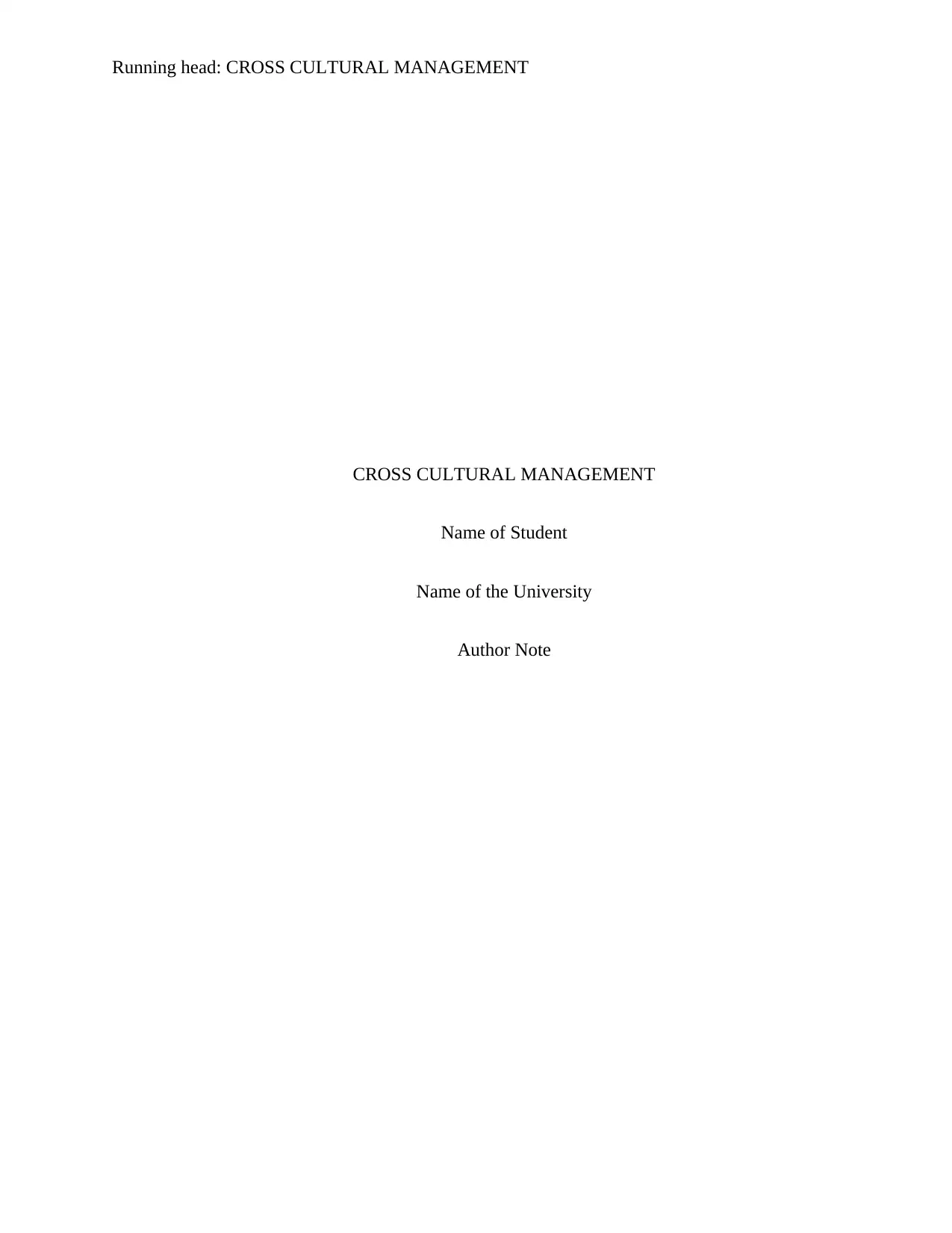
Running head: CROSS CULTURAL MANAGEMENT
CROSS CULTURAL MANAGEMENT
Name of Student
Name of the University
Author Note
CROSS CULTURAL MANAGEMENT
Name of Student
Name of the University
Author Note
Paraphrase This Document
Need a fresh take? Get an instant paraphrase of this document with our AI Paraphraser
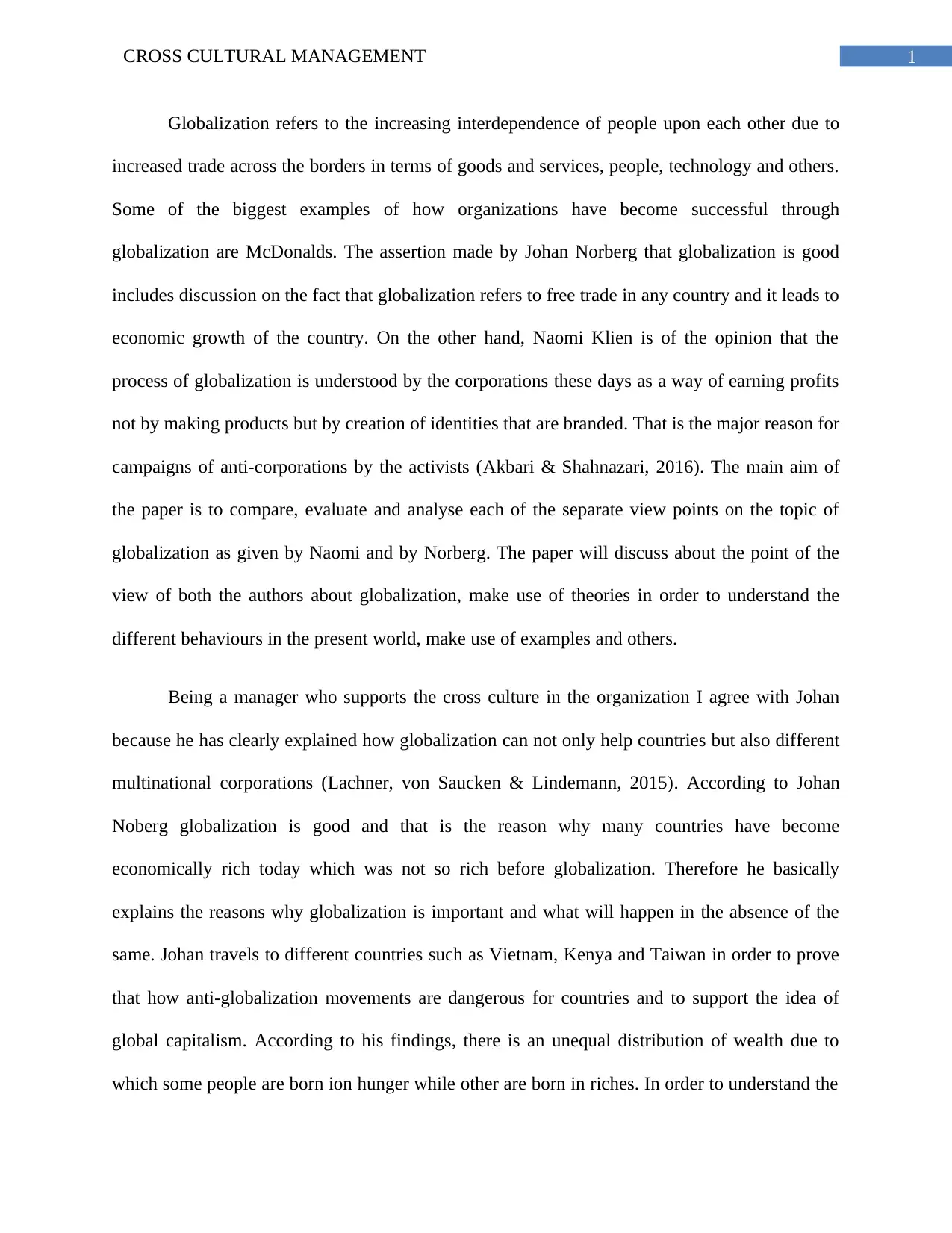
1CROSS CULTURAL MANAGEMENT
Globalization refers to the increasing interdependence of people upon each other due to
increased trade across the borders in terms of goods and services, people, technology and others.
Some of the biggest examples of how organizations have become successful through
globalization are McDonalds. The assertion made by Johan Norberg that globalization is good
includes discussion on the fact that globalization refers to free trade in any country and it leads to
economic growth of the country. On the other hand, Naomi Klien is of the opinion that the
process of globalization is understood by the corporations these days as a way of earning profits
not by making products but by creation of identities that are branded. That is the major reason for
campaigns of anti-corporations by the activists (Akbari & Shahnazari, 2016). The main aim of
the paper is to compare, evaluate and analyse each of the separate view points on the topic of
globalization as given by Naomi and by Norberg. The paper will discuss about the point of the
view of both the authors about globalization, make use of theories in order to understand the
different behaviours in the present world, make use of examples and others.
Being a manager who supports the cross culture in the organization I agree with Johan
because he has clearly explained how globalization can not only help countries but also different
multinational corporations (Lachner, von Saucken & Lindemann, 2015). According to Johan
Noberg globalization is good and that is the reason why many countries have become
economically rich today which was not so rich before globalization. Therefore he basically
explains the reasons why globalization is important and what will happen in the absence of the
same. Johan travels to different countries such as Vietnam, Kenya and Taiwan in order to prove
that how anti-globalization movements are dangerous for countries and to support the idea of
global capitalism. According to his findings, there is an unequal distribution of wealth due to
which some people are born ion hunger while other are born in riches. In order to understand the
Globalization refers to the increasing interdependence of people upon each other due to
increased trade across the borders in terms of goods and services, people, technology and others.
Some of the biggest examples of how organizations have become successful through
globalization are McDonalds. The assertion made by Johan Norberg that globalization is good
includes discussion on the fact that globalization refers to free trade in any country and it leads to
economic growth of the country. On the other hand, Naomi Klien is of the opinion that the
process of globalization is understood by the corporations these days as a way of earning profits
not by making products but by creation of identities that are branded. That is the major reason for
campaigns of anti-corporations by the activists (Akbari & Shahnazari, 2016). The main aim of
the paper is to compare, evaluate and analyse each of the separate view points on the topic of
globalization as given by Naomi and by Norberg. The paper will discuss about the point of the
view of both the authors about globalization, make use of theories in order to understand the
different behaviours in the present world, make use of examples and others.
Being a manager who supports the cross culture in the organization I agree with Johan
because he has clearly explained how globalization can not only help countries but also different
multinational corporations (Lachner, von Saucken & Lindemann, 2015). According to Johan
Noberg globalization is good and that is the reason why many countries have become
economically rich today which was not so rich before globalization. Therefore he basically
explains the reasons why globalization is important and what will happen in the absence of the
same. Johan travels to different countries such as Vietnam, Kenya and Taiwan in order to prove
that how anti-globalization movements are dangerous for countries and to support the idea of
global capitalism. According to his findings, there is an unequal distribution of wealth due to
which some people are born ion hunger while other are born in riches. In order to understand the
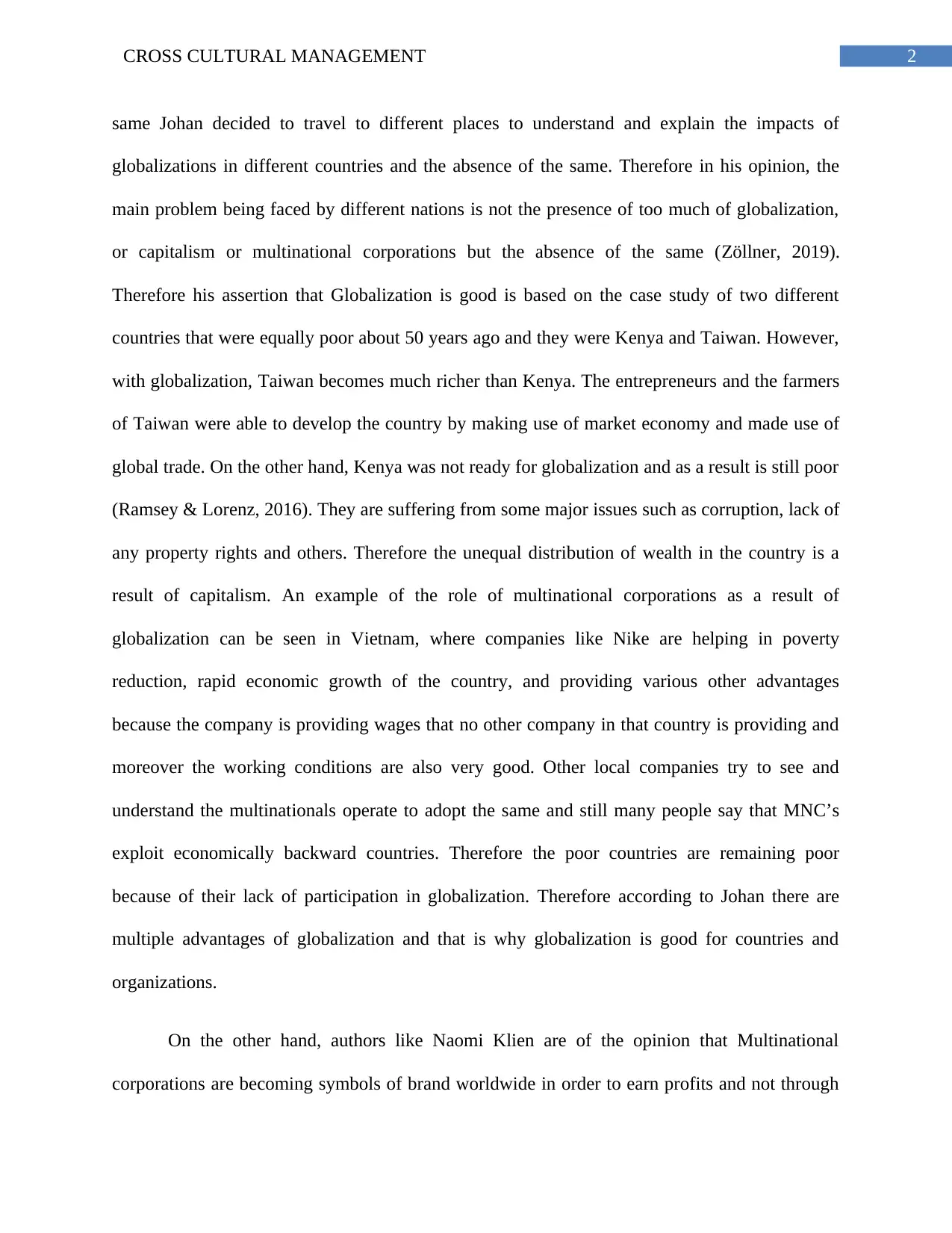
2CROSS CULTURAL MANAGEMENT
same Johan decided to travel to different places to understand and explain the impacts of
globalizations in different countries and the absence of the same. Therefore in his opinion, the
main problem being faced by different nations is not the presence of too much of globalization,
or capitalism or multinational corporations but the absence of the same (Zöllner, 2019).
Therefore his assertion that Globalization is good is based on the case study of two different
countries that were equally poor about 50 years ago and they were Kenya and Taiwan. However,
with globalization, Taiwan becomes much richer than Kenya. The entrepreneurs and the farmers
of Taiwan were able to develop the country by making use of market economy and made use of
global trade. On the other hand, Kenya was not ready for globalization and as a result is still poor
(Ramsey & Lorenz, 2016). They are suffering from some major issues such as corruption, lack of
any property rights and others. Therefore the unequal distribution of wealth in the country is a
result of capitalism. An example of the role of multinational corporations as a result of
globalization can be seen in Vietnam, where companies like Nike are helping in poverty
reduction, rapid economic growth of the country, and providing various other advantages
because the company is providing wages that no other company in that country is providing and
moreover the working conditions are also very good. Other local companies try to see and
understand the multinationals operate to adopt the same and still many people say that MNC’s
exploit economically backward countries. Therefore the poor countries are remaining poor
because of their lack of participation in globalization. Therefore according to Johan there are
multiple advantages of globalization and that is why globalization is good for countries and
organizations.
On the other hand, authors like Naomi Klien are of the opinion that Multinational
corporations are becoming symbols of brand worldwide in order to earn profits and not through
same Johan decided to travel to different places to understand and explain the impacts of
globalizations in different countries and the absence of the same. Therefore in his opinion, the
main problem being faced by different nations is not the presence of too much of globalization,
or capitalism or multinational corporations but the absence of the same (Zöllner, 2019).
Therefore his assertion that Globalization is good is based on the case study of two different
countries that were equally poor about 50 years ago and they were Kenya and Taiwan. However,
with globalization, Taiwan becomes much richer than Kenya. The entrepreneurs and the farmers
of Taiwan were able to develop the country by making use of market economy and made use of
global trade. On the other hand, Kenya was not ready for globalization and as a result is still poor
(Ramsey & Lorenz, 2016). They are suffering from some major issues such as corruption, lack of
any property rights and others. Therefore the unequal distribution of wealth in the country is a
result of capitalism. An example of the role of multinational corporations as a result of
globalization can be seen in Vietnam, where companies like Nike are helping in poverty
reduction, rapid economic growth of the country, and providing various other advantages
because the company is providing wages that no other company in that country is providing and
moreover the working conditions are also very good. Other local companies try to see and
understand the multinationals operate to adopt the same and still many people say that MNC’s
exploit economically backward countries. Therefore the poor countries are remaining poor
because of their lack of participation in globalization. Therefore according to Johan there are
multiple advantages of globalization and that is why globalization is good for countries and
organizations.
On the other hand, authors like Naomi Klien are of the opinion that Multinational
corporations are becoming symbols of brand worldwide in order to earn profits and not through
⊘ This is a preview!⊘
Do you want full access?
Subscribe today to unlock all pages.

Trusted by 1+ million students worldwide
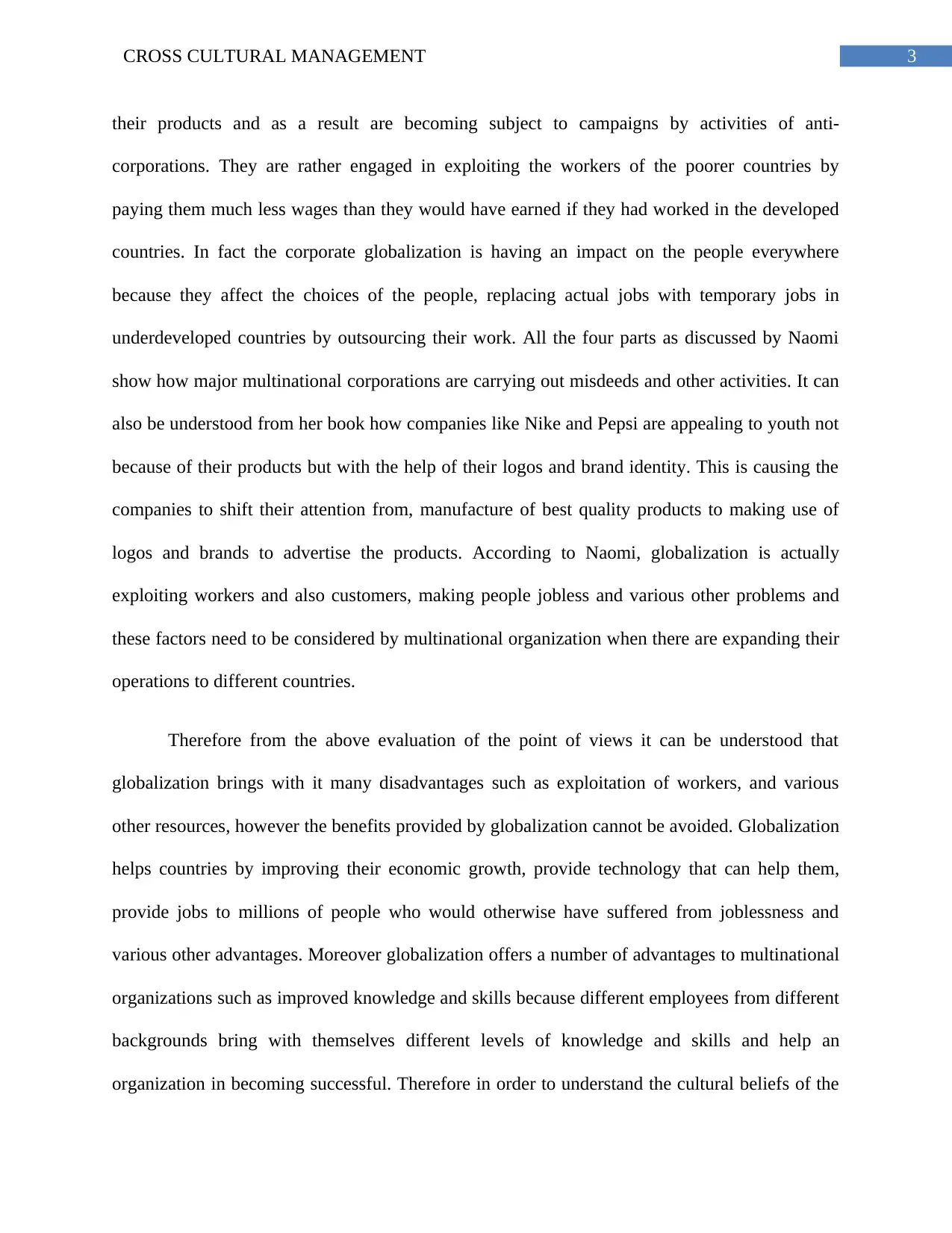
3CROSS CULTURAL MANAGEMENT
their products and as a result are becoming subject to campaigns by activities of anti-
corporations. They are rather engaged in exploiting the workers of the poorer countries by
paying them much less wages than they would have earned if they had worked in the developed
countries. In fact the corporate globalization is having an impact on the people everywhere
because they affect the choices of the people, replacing actual jobs with temporary jobs in
underdeveloped countries by outsourcing their work. All the four parts as discussed by Naomi
show how major multinational corporations are carrying out misdeeds and other activities. It can
also be understood from her book how companies like Nike and Pepsi are appealing to youth not
because of their products but with the help of their logos and brand identity. This is causing the
companies to shift their attention from, manufacture of best quality products to making use of
logos and brands to advertise the products. According to Naomi, globalization is actually
exploiting workers and also customers, making people jobless and various other problems and
these factors need to be considered by multinational organization when there are expanding their
operations to different countries.
Therefore from the above evaluation of the point of views it can be understood that
globalization brings with it many disadvantages such as exploitation of workers, and various
other resources, however the benefits provided by globalization cannot be avoided. Globalization
helps countries by improving their economic growth, provide technology that can help them,
provide jobs to millions of people who would otherwise have suffered from joblessness and
various other advantages. Moreover globalization offers a number of advantages to multinational
organizations such as improved knowledge and skills because different employees from different
backgrounds bring with themselves different levels of knowledge and skills and help an
organization in becoming successful. Therefore in order to understand the cultural beliefs of the
their products and as a result are becoming subject to campaigns by activities of anti-
corporations. They are rather engaged in exploiting the workers of the poorer countries by
paying them much less wages than they would have earned if they had worked in the developed
countries. In fact the corporate globalization is having an impact on the people everywhere
because they affect the choices of the people, replacing actual jobs with temporary jobs in
underdeveloped countries by outsourcing their work. All the four parts as discussed by Naomi
show how major multinational corporations are carrying out misdeeds and other activities. It can
also be understood from her book how companies like Nike and Pepsi are appealing to youth not
because of their products but with the help of their logos and brand identity. This is causing the
companies to shift their attention from, manufacture of best quality products to making use of
logos and brands to advertise the products. According to Naomi, globalization is actually
exploiting workers and also customers, making people jobless and various other problems and
these factors need to be considered by multinational organization when there are expanding their
operations to different countries.
Therefore from the above evaluation of the point of views it can be understood that
globalization brings with it many disadvantages such as exploitation of workers, and various
other resources, however the benefits provided by globalization cannot be avoided. Globalization
helps countries by improving their economic growth, provide technology that can help them,
provide jobs to millions of people who would otherwise have suffered from joblessness and
various other advantages. Moreover globalization offers a number of advantages to multinational
organizations such as improved knowledge and skills because different employees from different
backgrounds bring with themselves different levels of knowledge and skills and help an
organization in becoming successful. Therefore in order to understand the cultural beliefs of the
Paraphrase This Document
Need a fresh take? Get an instant paraphrase of this document with our AI Paraphraser
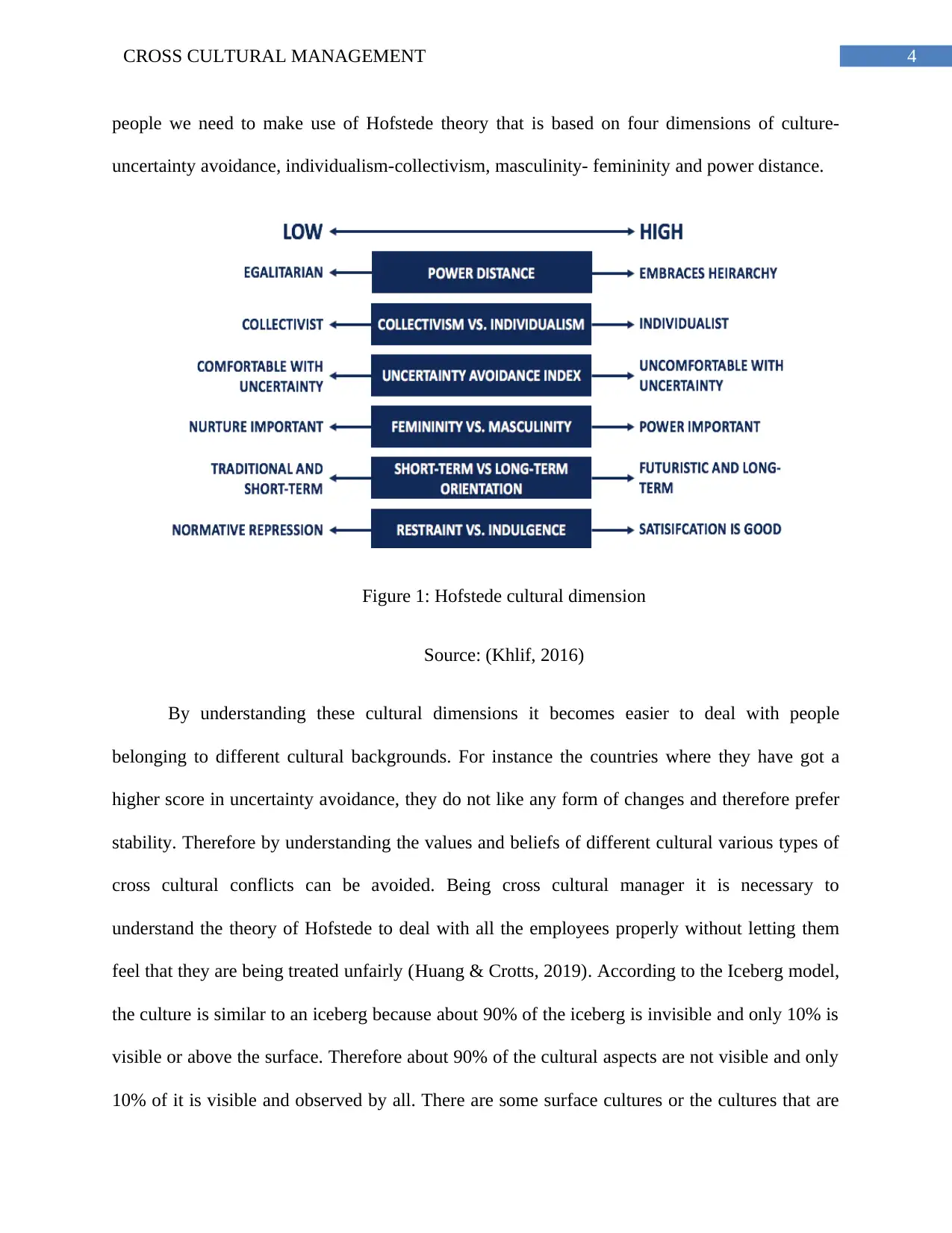
4CROSS CULTURAL MANAGEMENT
people we need to make use of Hofstede theory that is based on four dimensions of culture-
uncertainty avoidance, individualism-collectivism, masculinity- femininity and power distance.
Figure 1: Hofstede cultural dimension
Source: (Khlif, 2016)
By understanding these cultural dimensions it becomes easier to deal with people
belonging to different cultural backgrounds. For instance the countries where they have got a
higher score in uncertainty avoidance, they do not like any form of changes and therefore prefer
stability. Therefore by understanding the values and beliefs of different cultural various types of
cross cultural conflicts can be avoided. Being cross cultural manager it is necessary to
understand the theory of Hofstede to deal with all the employees properly without letting them
feel that they are being treated unfairly (Huang & Crotts, 2019). According to the Iceberg model,
the culture is similar to an iceberg because about 90% of the iceberg is invisible and only 10% is
visible or above the surface. Therefore about 90% of the cultural aspects are not visible and only
10% of it is visible and observed by all. There are some surface cultures or the cultures that are
people we need to make use of Hofstede theory that is based on four dimensions of culture-
uncertainty avoidance, individualism-collectivism, masculinity- femininity and power distance.
Figure 1: Hofstede cultural dimension
Source: (Khlif, 2016)
By understanding these cultural dimensions it becomes easier to deal with people
belonging to different cultural backgrounds. For instance the countries where they have got a
higher score in uncertainty avoidance, they do not like any form of changes and therefore prefer
stability. Therefore by understanding the values and beliefs of different cultural various types of
cross cultural conflicts can be avoided. Being cross cultural manager it is necessary to
understand the theory of Hofstede to deal with all the employees properly without letting them
feel that they are being treated unfairly (Huang & Crotts, 2019). According to the Iceberg model,
the culture is similar to an iceberg because about 90% of the iceberg is invisible and only 10% is
visible or above the surface. Therefore about 90% of the cultural aspects are not visible and only
10% of it is visible and observed by all. There are some surface cultures or the cultures that are
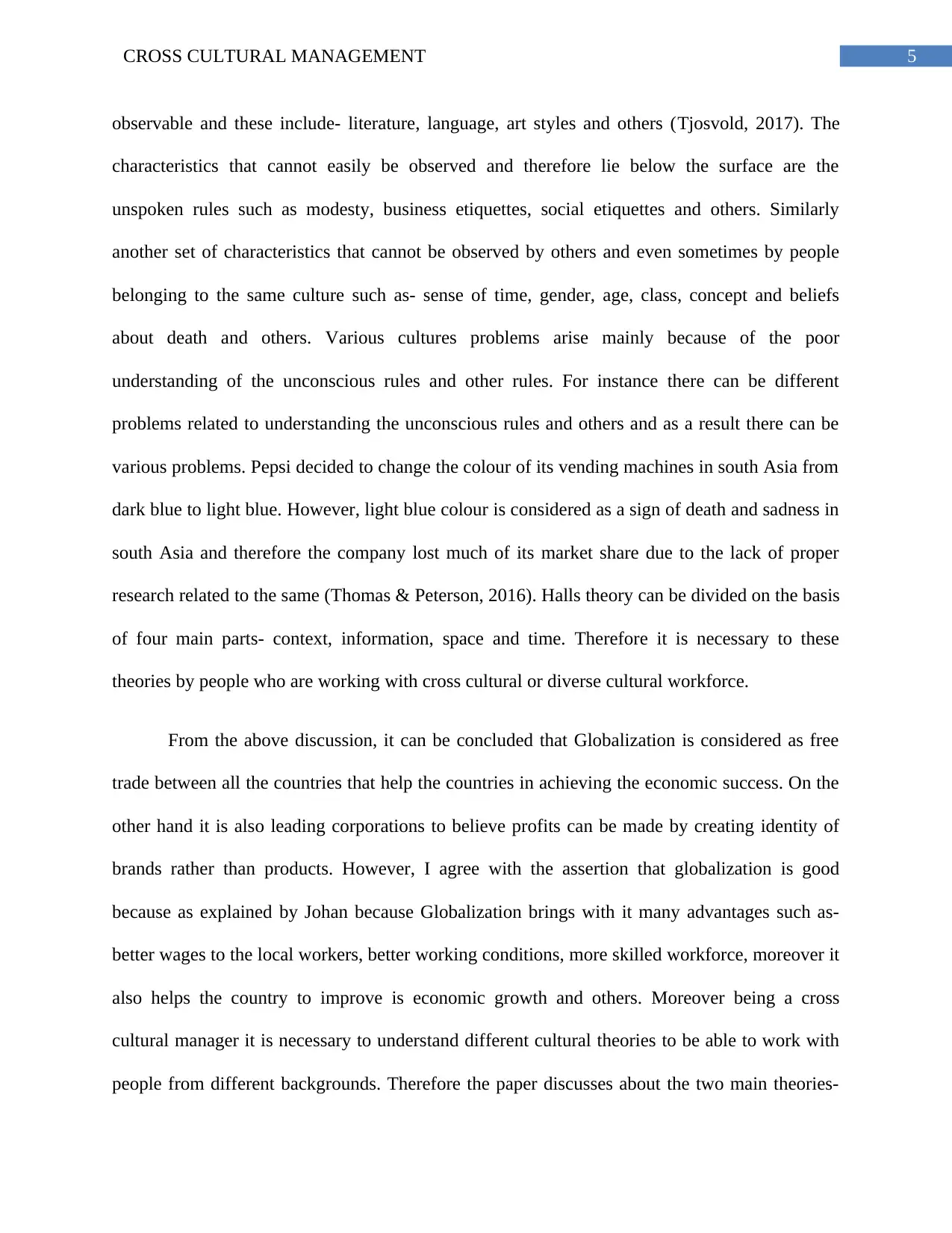
5CROSS CULTURAL MANAGEMENT
observable and these include- literature, language, art styles and others (Tjosvold, 2017). The
characteristics that cannot easily be observed and therefore lie below the surface are the
unspoken rules such as modesty, business etiquettes, social etiquettes and others. Similarly
another set of characteristics that cannot be observed by others and even sometimes by people
belonging to the same culture such as- sense of time, gender, age, class, concept and beliefs
about death and others. Various cultures problems arise mainly because of the poor
understanding of the unconscious rules and other rules. For instance there can be different
problems related to understanding the unconscious rules and others and as a result there can be
various problems. Pepsi decided to change the colour of its vending machines in south Asia from
dark blue to light blue. However, light blue colour is considered as a sign of death and sadness in
south Asia and therefore the company lost much of its market share due to the lack of proper
research related to the same (Thomas & Peterson, 2016). Halls theory can be divided on the basis
of four main parts- context, information, space and time. Therefore it is necessary to these
theories by people who are working with cross cultural or diverse cultural workforce.
From the above discussion, it can be concluded that Globalization is considered as free
trade between all the countries that help the countries in achieving the economic success. On the
other hand it is also leading corporations to believe profits can be made by creating identity of
brands rather than products. However, I agree with the assertion that globalization is good
because as explained by Johan because Globalization brings with it many advantages such as-
better wages to the local workers, better working conditions, more skilled workforce, moreover it
also helps the country to improve is economic growth and others. Moreover being a cross
cultural manager it is necessary to understand different cultural theories to be able to work with
people from different backgrounds. Therefore the paper discusses about the two main theories-
observable and these include- literature, language, art styles and others (Tjosvold, 2017). The
characteristics that cannot easily be observed and therefore lie below the surface are the
unspoken rules such as modesty, business etiquettes, social etiquettes and others. Similarly
another set of characteristics that cannot be observed by others and even sometimes by people
belonging to the same culture such as- sense of time, gender, age, class, concept and beliefs
about death and others. Various cultures problems arise mainly because of the poor
understanding of the unconscious rules and other rules. For instance there can be different
problems related to understanding the unconscious rules and others and as a result there can be
various problems. Pepsi decided to change the colour of its vending machines in south Asia from
dark blue to light blue. However, light blue colour is considered as a sign of death and sadness in
south Asia and therefore the company lost much of its market share due to the lack of proper
research related to the same (Thomas & Peterson, 2016). Halls theory can be divided on the basis
of four main parts- context, information, space and time. Therefore it is necessary to these
theories by people who are working with cross cultural or diverse cultural workforce.
From the above discussion, it can be concluded that Globalization is considered as free
trade between all the countries that help the countries in achieving the economic success. On the
other hand it is also leading corporations to believe profits can be made by creating identity of
brands rather than products. However, I agree with the assertion that globalization is good
because as explained by Johan because Globalization brings with it many advantages such as-
better wages to the local workers, better working conditions, more skilled workforce, moreover it
also helps the country to improve is economic growth and others. Moreover being a cross
cultural manager it is necessary to understand different cultural theories to be able to work with
people from different backgrounds. Therefore the paper discusses about the two main theories-
⊘ This is a preview!⊘
Do you want full access?
Subscribe today to unlock all pages.

Trusted by 1+ million students worldwide

6CROSS CULTURAL MANAGEMENT
Hofstede and Iceberg model can help in understanding the various cultural aspects and therefore
overcoming various cultural barriers.
Hofstede and Iceberg model can help in understanding the various cultural aspects and therefore
overcoming various cultural barriers.
Paraphrase This Document
Need a fresh take? Get an instant paraphrase of this document with our AI Paraphraser
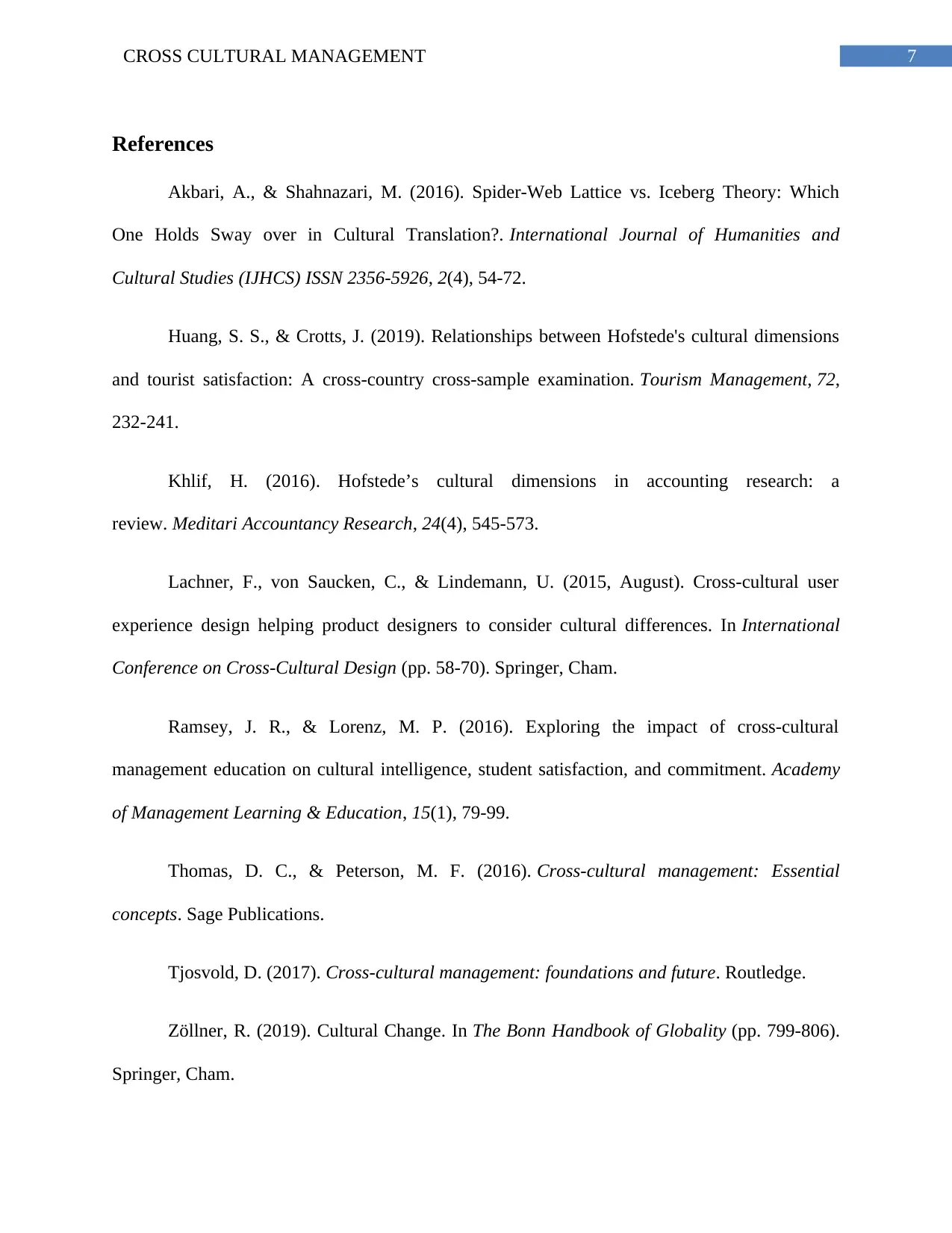
7CROSS CULTURAL MANAGEMENT
References
Akbari, A., & Shahnazari, M. (2016). Spider-Web Lattice vs. Iceberg Theory: Which
One Holds Sway over in Cultural Translation?. International Journal of Humanities and
Cultural Studies (IJHCS) ISSN 2356-5926, 2(4), 54-72.
Huang, S. S., & Crotts, J. (2019). Relationships between Hofstede's cultural dimensions
and tourist satisfaction: A cross-country cross-sample examination. Tourism Management, 72,
232-241.
Khlif, H. (2016). Hofstede’s cultural dimensions in accounting research: a
review. Meditari Accountancy Research, 24(4), 545-573.
Lachner, F., von Saucken, C., & Lindemann, U. (2015, August). Cross-cultural user
experience design helping product designers to consider cultural differences. In International
Conference on Cross-Cultural Design (pp. 58-70). Springer, Cham.
Ramsey, J. R., & Lorenz, M. P. (2016). Exploring the impact of cross-cultural
management education on cultural intelligence, student satisfaction, and commitment. Academy
of Management Learning & Education, 15(1), 79-99.
Thomas, D. C., & Peterson, M. F. (2016). Cross-cultural management: Essential
concepts. Sage Publications.
Tjosvold, D. (2017). Cross-cultural management: foundations and future. Routledge.
Zöllner, R. (2019). Cultural Change. In The Bonn Handbook of Globality (pp. 799-806).
Springer, Cham.
References
Akbari, A., & Shahnazari, M. (2016). Spider-Web Lattice vs. Iceberg Theory: Which
One Holds Sway over in Cultural Translation?. International Journal of Humanities and
Cultural Studies (IJHCS) ISSN 2356-5926, 2(4), 54-72.
Huang, S. S., & Crotts, J. (2019). Relationships between Hofstede's cultural dimensions
and tourist satisfaction: A cross-country cross-sample examination. Tourism Management, 72,
232-241.
Khlif, H. (2016). Hofstede’s cultural dimensions in accounting research: a
review. Meditari Accountancy Research, 24(4), 545-573.
Lachner, F., von Saucken, C., & Lindemann, U. (2015, August). Cross-cultural user
experience design helping product designers to consider cultural differences. In International
Conference on Cross-Cultural Design (pp. 58-70). Springer, Cham.
Ramsey, J. R., & Lorenz, M. P. (2016). Exploring the impact of cross-cultural
management education on cultural intelligence, student satisfaction, and commitment. Academy
of Management Learning & Education, 15(1), 79-99.
Thomas, D. C., & Peterson, M. F. (2016). Cross-cultural management: Essential
concepts. Sage Publications.
Tjosvold, D. (2017). Cross-cultural management: foundations and future. Routledge.
Zöllner, R. (2019). Cultural Change. In The Bonn Handbook of Globality (pp. 799-806).
Springer, Cham.
1 out of 8
Related Documents
Your All-in-One AI-Powered Toolkit for Academic Success.
+13062052269
info@desklib.com
Available 24*7 on WhatsApp / Email
![[object Object]](/_next/static/media/star-bottom.7253800d.svg)
Unlock your academic potential
Copyright © 2020–2025 A2Z Services. All Rights Reserved. Developed and managed by ZUCOL.



